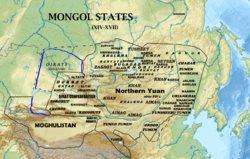Kara Del
| Kara Del | ||||||||||||
| ||||||||||||
 Location of Kara Del | ||||||||||||
| Capital | Hami | |||||||||||
| Languages | Mongolian, Old Uyghur language | |||||||||||
| Government | Monarchy | |||||||||||
| Khan | Gunashiri | |||||||||||
| Historical era | Post-classical | |||||||||||
| • | Gunashiri breaks away from Northern Yuan dynasty | c. 1389 | ||||||||||
| • | Kara Del accepts Ming supremacy | 1404 | ||||||||||
| • | Conquered by Esen of the Northern Yuan dynasty based in Mongolia proper | 1430s | ||||||||||
| • | Coup staged by pro-Mongol faction | 1463 | ||||||||||
| • | Ming restores Gunashiri dynasty | 1467 | ||||||||||
| • | Mansur Khan from the Chagatai Khanate overthrew the Gunashiri dynasty and the region's conversion to Islam | 1513 | ||||||||||
| ||||||||||||
| Today part of | | |||||||||||
| History of the Mongols |
|---|
|
Timeline · History · Rulers · Nobility Culture · Language · Proto-Mongols |
|
|
|
Part of a series on the |
|---|
| History of Xinjiang |
Kara Del or Qara Del was a Mongol kingdom that existed in Hami in present-day Xinjiang. It was founded by the Yuan prince Gunashiri, a descendant of Chagatai Khan, in the late 14th century (c.1389), and ruled by the Chagatayids thereafter until 1463. It was destroyed as results of the wars between Ming China and Oirat Mongols and dynastic succession struggles in 1513. Kara Del means "Black chest" in the Mongolian language.
History
After the demise of the Northern Yuan emperor Tögüs Temür, Kublai Khan's (r. 1260-1294) descendant, the throne of Mongolia passed into the hands of Jorightu Khan Yesüder, an Arib-Bokid prince, in 1388. With the anarchy after the Mongol Emperor's death, Chagatai Khan's descendant, Gunashiri, who followed the Yuan court's retreat into Mongolia, attempted to break away from the new Khan's rule. By 1390, Gunashiri, himself Buddhist, successfully established himself in Hami where the Uighurs lived.[1]
Buddhism survived in Uyghurstan (Turfan and Qocho). during the Ming dynasty.[2]
The Kara Del accepted the Ming supremacy to save its existence in 1404, and came under Ming control as Hami Prefecture.[3] The Kara Del ruler Enke-temur was granted the title Zhongshunwang (meaning the obedient prince) by the Ming court.[4] However, they were threatened by Mongolian Emperors, particularly during the reign of Yesüder, from the north. The Oirats from Western Mongolia pressured into the kingdom from 15th century on. Their leader and Yuan taishi, Esen, (future Emperor of the Mongols) forced the Kara Del khan to submit in 1430s. The kingdom was one of two Chagatyid realms conquered by Esen, other one being Moghulistan (c. 1432). He extensively supported the rivalry between successor of Gunashiri and intervened in their dynastic struggles. The Ming Dynasty was trying to place their puppet on the throne to secure their claim at the time.
In 1463 the khan was overthrown by a pro-Mongol faction and a serious succession crisis started. From 1467 Ming Emperors reinstalled members of Gunashiri's house but the failure was evident. Hami was conquered by Mansur, the khan from another branch of the Chagatayids in Central Asia, putting an end to the dynasty in 1513. Mansur forcefully converted all people living in Kara Del to Islam.[5]
It was reported that between Khitay and Khotan the Sarigh Uyghur tribes who were "impious" resided, and they were targeted for ghazat (holy war) by Mansur Khan following 1516.[6][7]
Popular Culture
Kara Del is a playable nation in Europa Universalis IV.
List of rulers of Kara Del
According to Chinese Wikipedia:
- Gunashiri (兀納失里) (1380-1393)
- Enke Timur (安克帖木兒) (1393-1405) (He was vassal of China since June 1404)
- Tuō Tuō (脫脫 (哈密國) (1405-1411) (He was vassal of China)
- Tù Lì Tiē Mù Er (兔力帖木兒) (1411-1425) (He was vassal of China)
- Bo Dá Shī Lǐ (卜答失里) (1425-1439) (He was firstly vassal of China, later of Northern Yuan dynasty). He was rivalled firstly Tuō Huān Tiē Mù Er (脱欢帖木儿) (1427-1437) and Tuō Tuō Tǎ Mù Er (脱脱塔木儿) (1437-1439), the son of rival.
- Hā Lì Suǒ Lǔ Tán (哈力锁鲁檀) (1439-1457) (He was vassal firstly of Northern Yuan dynasty till 1455, later of China)
- Bo Liè Gé (卜列革) (1457-1460)
Rivalry between Nǔ Wēn Dá Shī Lǐ (努溫答失里) (1460-1472) and Bǎ Tǎ Mù Er (把塔木儿) (1466-1472)
- Hǎn Shèn (罕慎) (1472-1488)
- Yǎn Kè Bèi Lá(奄克孛剌) (1488-1492) and (1493-1497)
- Shǎn Bā (陕巴) (1492-1493) and (1497-1505)
- Bài Yá Jí (拜牙即) (1505-1513)
See also
References
- ↑ Ed. Reuven Amitai-Preiss, Reuven Amitai, David Morgan-The Mongol empire and its legacy, p.294
- ↑ Saintly Brokers: Uyghur Muslims, Trade, and the Making of Qing Central Asia, 1696--1814. ProQuest. 2008. pp. 75–. ISBN 978-1-109-10126-3.
- ↑ C.P.Atwood-Encyclopedia of Mongolia and the Mongol Empire, p. 564
- ↑ Kim 2008, p. 68.
- ↑ 哈密回王简史-回王家族的初始 - 哈密政府网
- ↑ Tōyō Bunko (Japan) (1986). Memoirs of the Research Department. p. 3.
- ↑ Tōyō Bunko (Japan); Tōyō Bunko (Japan). (1983). Memoirs of the Research Department of the Toyo Bunko: (the Oriental Library). Tôyô Bunko. p. 3.